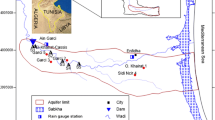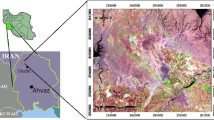Abstract
Although Pingtung plain is an agriculturally developed region, its limited hydrologic conditions have restrained the maximization of its surface water resources. Due to the lack of proper management and sustainable utilization, groundwater has been overdrawn, causing serious land subsidence and seawater intrusion. The present paper presents a pilot study for artificially recharging groundwater using high-infiltration basins. Results of the geometric factor show that the large basin is ca. 6.8 times the size of the small one, with the infiltration volume almost approaching 1 m3/day/m2. In the groundwater variation, the MW-2 is located immediately below the infiltration basin; therefore, its water level rises more rapidly than that of MW-3. As for the infiltration volume, results of the experiment used the same basin since 2002, which shows that the volumes gradually decreased from 12,136 to 5,555 m3/day. This is particularly evident in 2005 when volume decrease was at a maximum ca. 2,000 m3/day. Finally, the infiltration rate decreased from 22.76 to 7.15 m/day. The difference in infiltration rate between 2003 and 2005 has a maximum variation from to 15.2 to 10.33 m/day. In 2003, the addition of sand caused the infiltration rate to fall to a minimum ca. 5.3 m/day. By extending the recharge time, the infiltration rate fell gradually similar to those identified from 2005 to 2007.








Similar content being viewed by others
References
Bouwer H (1999) Artificial recharge of groundwater systems, design and management. In: Mays LW (ed) Hydraulic design handbook. McGraw-Hill, New York, pp 24.1–24.44
Carlson RD, Lindstedt KD, Bennett ER, Hartman RB (1982) Rapid infiltration treatment of primary and secondary effluents. J Water Pollut Control Fed 54(3)Part I:270–280
CTCI (2002) Integrated plan of water resources development and protection for Pingtung county and groundwater recharge of groundwater project at the proximal fan of Linpien Alluvial Plain, Taiwan. Project Report. Pingtung County, Taiwan (in Chinese with English abstract)
Hsu CM, Chang HC, Wang Y (1985) Fault-induced fissures at the Tulungwan fault zone, southern Taiwan, and its neotectonic implications: acta Geologica Taiwanica, 23:197–207
Johnson JS, Baker LA, Fox P (1999) Geochemical transformations during artificial groundwater recharge: soil–water interactions of inorganic constituents. Water Res 33(1):196–206
Leach LE, Enfield CG, Harlin CC Jr (1980) Summary of long-term rapid infiltration system studies. US Environmental Protection Agency, Ada, OK, Report No. EPA-600/2080-165
Legg C, Sagstad S (2002) Optimization and use of various recharge techniques for reclaimed wastewater at a sensitive site in Glendale, Arizona. In: Dillon PJ (ed) Management of aquifer recharge for sustainability, swets & zeitlinger, Lisse, pp 333–338
Lluria M (2002) Geophysics for site selection, monitoring and operation of groundwater recharge projects, proceedings of 4th international symposium on artificial recharge of groundwater, Adelaide, Australia, A.A. Balkema publishers Rotterdam, pp 547–552, ISBN: 90-5809-527-4
Meng CY (1967) The structural development of the southern half of western Taiwan: Petrol. Geol, Taiwan, 2:1–20
Pérez-Parício A, Carrera J (1998) Operation guidelines regarding clogging, artificial recharge of groundwater. Proceedings of the third international symposium on groundwater recharge. A. Balkema Publish Co, pp 441–445
Rastogi AK, Pandey SN (2002) Influence of artificial recharge basin shapes on the mound underneath in phreatic aquifers, proceedings of 4th international symposium on artificial recharge of groundwater. Adelaide, Australia, A.A. Balkema Publishers Rotterdam, pp 295–297, ISBN: 90-5809-527-4
Rice RC, Bouwer H (1984) Soil-aquifer treatment using primary effluent. J Water Pollut Control Fed 56(1):84–88
Stuyfzand PJ (2002) Quantifying the hydrogeochemical impact and sustainability of artificial recharge systems, proceedings of 4th international symposium on artificial recharge of groundwater. Adelaide, Australia, A.A. Balkema publishers Rotterdam, pp 77–82, ISBN: 90-5809-527-4
Ting CS (1997) Groundwater resources evaluation and management for pingtung plain, Taiwan. Dissertation, Free University, Amsterdam, ISBN 90-9008794-X
Ting CS, Lin CY, Chuang CH, Liu CC (2002) Pilot study for artificial recharge of groundwater using high rate infiltration basins in Pingtung Plain, Taiwan. In: Dillon PJ (ed) Management of aquifer recharge for sustainability. Proceedings of the 4th international symposium on artificial recharge of groundwater, ISAR-4, Adelaide, South Australia, pp 22–26
Van Breukelen BM, Appelo CAJ, Olsthoorn TN (1998) Hydrogeochemical transport modeling of 24 years of Rhine water infiltration in the dunes of the Amsterdam water supply. J Hydrol 209(1–4):281–296
Vengosh A, Keren R (1996) Chemical modifications of groundwater contaminated by recharge of treated sewage effluent. J Contam Hydrol 23:347–360
Yen TP, Tien PL (1986) Chao-chou fault in Southern Taiwan, proceedings of geology society. China, 29:9–22
Yun-Zheng P, Jian-long W (2006) A field study of advanced municipal wastewater treatment technology for artificial groundwater recharge. J Environ Sci 18(6):1056–1060
Zare M, Raeisi E, Zeqnali A (2002) Study on the reduction of infiltration rate of Emamzadeh Jaafar artificial recharge project, Iran, proceedings of 4th international symposium on artificial recharge of groundwater, Adelaide, Australia, A.A. Balkema Publishers Rotterdam, pp 231–236, ISBN: 90-5809-527-4
Acknowledgments
Yung-Chang Tu, Hsin-Tien Tsai and Jung-Wei Chen contributed equally to the success of the research. The authors wish to thank the Water Resources Agency of the Ministry of Economic Affairs (MOEAWRA0960321) and the Ministry of Education, Taiwan, R.O.C. under the NCKU Project for Promoting Academic Excellence & Developing World Class Research Centre.
Author information
Authors and Affiliations
Corresponding author
Rights and permissions
About this article
Cite this article
Tu, YC., Ting, CS., Tsai, HT. et al. Dynamic analysis of the infiltration rate of artificial recharge of groundwater: a case study of Wanglong Lake, Pingtung, Taiwan. Environ Earth Sci 63, 77–85 (2011). https://doi.org/10.1007/s12665-010-0670-8
Received:
Accepted:
Published:
Issue Date:
DOI: https://doi.org/10.1007/s12665-010-0670-8




